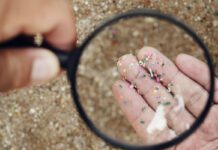
Scientists’ glowing endorsements of Oxford Nanopore’s MiniION portable DNA sequencer, as reported in the media in mid-October, suggest a host of potentially revolutionary applications, in areas such as epidemiology, crop management and environmental monitoring, are not too far over the horizon.
The palm-sized device is unable to read long genomes, or to do so with the accuracy of the conventional, room-sized DNA-sequencing equipment found in genetics laboratories. But it is small, cheap (around $1000) and relatively fast. In April, a group working in Guinea were able to read the genomes of 14 Ebola samples within 48 hours of their being taken from patients, according to The Guardian.
How is it used and how does it work?
At present the technique allows bacteria and viruses to be identified quickly from their DNA. To prepare samples for the device still takes around two hours of lab work. These are then put into a flow cell within the device, which detects individual DNA bases as they pass through a tiny ‘nanopore’ – a proprietary structure made of genetically-engineered proteins that can be tuned to recognise different molecules in solution.
A binding interaction between the nanopore and a target molecule in the sample blocks the electrical current flowing between two chambers filled with electrically-conducting solution. This provides an electronic signature of the binding event, which can be used to identify the molecule.
The approach uses relatively simple electronics, and is therefore a candidate for the kind of portability now realised by the MiniION device. Size appears to be the really significant aspect of the advance, the fact that until now it “hasn’t been possible to pack a DNA sequencer in your suitcase,” according to Camilla Ip, a scientist working at the Oxford Genomics Centre, as reported in The Guardian.
That, and the fact that tests can be performed in the field, with results forthcoming in a relatively short time, without having to take samples back to the lab.
Analysing bacteria present in the air
In March scientists at The Genome Analysis Centre (TGAC) in Norwich evaluated the MiniION device in the genetic sequencing of environmental samples. Diseases in crops, animals and humans are often spread via bacteria, viruses and spores in the surrounding air. The low levels of biological material available for measurement tends to present technical issues, which the team claimed they were able to overcome to some extent in the way they used the MiniION.
GAC researchers used MiniION in conjunction with the bioinformatics tool Kontaminant, adapting it to analyse samples and identify species as they were being sequenced on the MiniION. “In-field surveillance presents a number of hurdles. With its compact size, cheap device cost, simple library preparation and streaming nature, the MiniION provides a significant step towards addressing these challenges,” said Dr Richard Leggett, a project leader in the Data Infrastructure & Algorithms Group at TGAC.
Oxford Nanopore suggests it will soon be possible to connect its device to a smartphone, and plans to offer a pay-as-you-go pricing model, which could open up access to genetic sequencing to a very wide audience.






